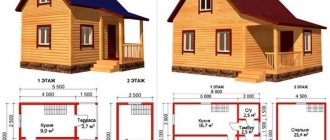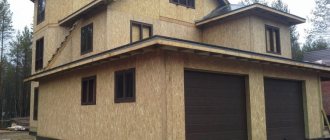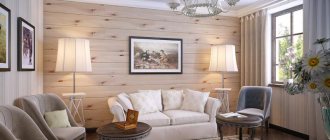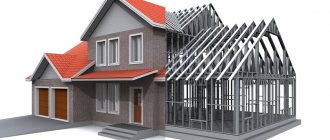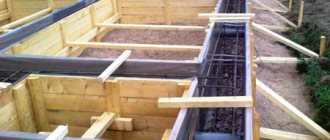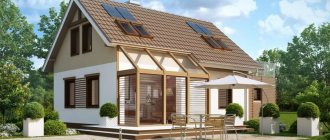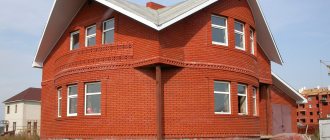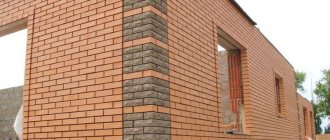Most people associate container houses with a simple change house, a temporary country home. In fact, buildings can amaze with their unusual appearance, which directly depends on a correctly drawn up project and design concept. This type of construction has been actively used in European and American countries for several decades. In the post-Soviet space it is just beginning to gain momentum.
Multi-room, multi-story buildings can be built from reusable containers designed for storing and transporting various items. In conditions of constant growth in real estate prices, this option will become a worthy alternative to standard buildings built from familiar materials. With minimal expenditure of money on construction work, you can get a functional, comfortable, cozy residential building.
History - how long ago did container buildings appear?
Containers became popular after World War II. The first models, which could be transferred from vehicles to rail or sea without loading/unloading contents, were developed in the 1950s by Malcolm McLean. A trial shipment was carried out in April 1956, after which the container revolution began. It is unlikely that the entrepreneur imagined that his invention would be used as a home.
When and under what circumstances these structures began to be used for the construction of a residential building is impossible to determine; the founder is unknown. The first mention of the possibility of using products as temporary housing is found in the archives of the US Army, in a document from 1977. Later, in 1987, Philip Clarke applied for a patent, the American architect proposed to build housing from reusable containers.
However, Adam Kalkin popularized this type of construction and became the father of container architecture. He is one of the most orthodox practitioners of architecture and a self-described artist. A graduate of England's Vassar College, he studied architectural art in London. He began working with containers in 1992 in New Jersey, USA, and subsequently founded his own company and became known throughout the world.
Layout
A 12-meter house is comparable in area to a studio apartment. When planning, you can focus on ready-made projects. There is a combined bathroom and a living room connected to the kitchen. This block has enough space to divide the space into areas for work and relaxation.
A small sea container is not well suited for use as a full-fledged home - it is quite difficult to create a comfortable layout for 12 m2. To visually expand the space, you can use mirrors. Such buildings are usually used as seasonal housing, or as additional modules to the main building.
Features of container houses
Anyone can build a structure from modules; this does not even require special education. It is enough to study the topic well and understand the technology. Containers provide endless possibilities for creating interesting projects. The finished structure has a block structure and can be welded or collapsible (transformable). Each element is replaceable, which is impossible to imagine in a standard house.
Container buildings can be used seasonally and year-round. When constructing temporary housing, no documents are required. For permanent residential buildings, you will have to obtain a construction permit.
Construction made from reusable containers is also called semi-finished housing. During construction, different blocks are selected according to the created sketch, from which the structure is formed. In a cottage built from separate parts, window and door openings are cut out, electricity, plumbing communications, gas are supplied to it, for which you also need to obtain permission from the relevant service, or use gas cylinders.
The main feature of any buildings made of this material is the fixed, rectangular size of the rooms. If the length can be adjusted by cutting the elements into individual components, then the value of the height and width is unchanged. Of course, using different sized models in your work, it is easy to achieve a good result, but their variety is small. And when constructing a permanent home, you will have to use only options that correspond in size to the current SNiPs and GOSTs, otherwise the project will not be registered with the BTI.
Non-residential buildings made from shipping containers
Perhaps many did not know, but not only houses, but also infrastructure facilities are built from containers. They are very popular among owners of roadside cafes and small restaurants. Often this structure becomes a kind of “home on wheels”, moving to new places every day.
Stephen Shoup created an entire mini office from such a structure, which was intended for a small start-up company. The dimensions of the container made it possible to place all the necessary equipment in it, and even divide the interior into several zones. The office was designed from 2 containers arranged in an L-shape:
Advantages and disadvantages
Houses built from marine or cargo reusable containers are characterized by a number of significant advantages. One of the main advantages is the relatively low cost. For little money you can purchase a ready-made block that will become a small house, a separate room, or a floor. The building also has the following positive characteristics:
- Strength. Thanks to this quality, they are used in seismically dangerous areas, in places where hurricanes, tornadoes, and other natural disasters are observed.
- Light weight. The weight of the product is insignificant, so installation does not require a capital foundation.
- Speed of construction work. Construction of a house will not take much time; even complex structures can be completed within 2-3 months, including exterior and interior decoration.
- Mobility. If necessary, the residential building can be disassembled and reassembled, and transported to another location.
- Innovation and creativity. The original designs stand out due to their appearance.
- Durability. With proper care and periodic maintenance, the house will last a long time.
- Versatility and practicality. Blocks can be combined with other building elements and included in projects for concrete, brick, and wooden buildings.
- Protection from unwanted fauna. Insects and rodents will not be able to enter the sealed container.
- Possibility of expansion. At any time you can increase the living space or add a new module.
When choosing this option, it is worth considering its inherent disadvantages. The main disadvantages include:
- Toxicity. Elements intended for the transportation of goods are treated with chemicals that protect the surface from negative atmospheric influences. It is necessary to remove the toxic layer.
- Fixed parameters. It is impossible to change the height of the ceilings or the width of the internal space.
- Coefficient of thermal conductivity. The metal heats up very quickly and does not retain heat. Very good thermal insulation will be required.
- Tightness. The material does not allow air to pass through, does not “breathe”. For a comfortable stay, you should organize high-quality ventilation.
- Corrosion. To extend the service life, you will have to constantly inspect the condition of the surface and eliminate various defects.
- Technical condition. It is difficult to find packaging on the secondary market that meets the requirements and does not have significant flaws.
- Seasonality. Most projects are not designed for year-round living. Budget options are not suitable for the comfortable existence of a full-fledged family.
Container options
There are two main types of containers that are most often used for building houses. Their length is 20 and 40 feet, and their weight is 2.3 and 3.9 tons.
There is another type of container - the 45-foot design, which has come into use in the last few years. It can be transported on regular trailers, but unlike its less competitive cousins, it provides a huge working space. With its advent, the conventional semi-trailer began to be used less frequently, which led to increased competition between cargo transportation companies.
The container is made of durable steel alloy, which makes it possible to install it in several rows. However, in private construction, the creation of tall structures is impractical .
The variety of options for shipping containers is not limited to 20, 40 and 45 foot blocks. There are specialized containers: tanks for gaseous and liquid substances, refrigerators, platforms, boxes for transporting animals.
Cost and construction costs
The cost of constructing a semi-finished building is significantly cheaper than standard housing. It depends on various factors. Includes a number of points:
- purchase of land;
- drafting;
- obtaining a construction permit for the construction of a capital structure;
- area of the planned housing, number of living rooms, number of floors;
- costs for construction materials and transportation;
- hiring special equipment for installation, a construction team;
- utility lines.
The price of the main element may vary. Purchasing a new product will require more money than purchasing a used model. The technical condition of the item and the place where it is sold are also taken into account; for example, in port cities it can be bought inexpensively. The price also depends on the type of product itself and its basic parameters.
The cost of transportation can be commensurate with the price of the container. But the largest investments fall on the purchase of finishing materials and wages of hired workers. When building a high-quality house suitable for permanent residence, you should not skimp on insulation; thermal insulation requires additional investments.
The costs of building a container building will be 30-50% less than building a house from traditional materials.
Price
The cost of such housing (even taking into account finishing) is 30% less than the price of a finished house of classical construction. On average, building a house with an area of 55 m2 will cost from 800 thousand rubles. It should be taken into account that the total cost of such housing is influenced by such factors as:
- the cost of the land plot on which the finished building will be installed;
- costs for design and obtaining permits in case of capital construction;
- number of floors and total area;
- transport and lifting works;
- hiring specialists if it is impossible to carry out the work independently;
- communications costs;
- purchase of building materials.
Additionally, the cost is influenced by the fact whether the containers purchased for construction will be new or used, which will be cheaper. If the installation site is located far from the port where the shipping containers are located, the distance may increase transportation costs. It will not be possible to save on thermal insulation materials, since such a house, with year-round use, requires high-quality insulation. Finishing can also significantly increase the budget - this is the most expensive item in the estimated cost of any home.
What containers are used to build houses?
For the construction of houses, any models designed for transporting goods are used. Some are suitable for organizing living rooms, others for arranging passages, hallways, and bathrooms. However, the choice is limited. Manufacturers produce a certain range of products regulated by the ISO 668 standard. Existing options are shown in the table:
| ISO classification | 1 EE | 1 EEE | 1A | 1AA | 1AAA | 1B | 1BB | 1BBB | 1C | 1CC |
| Standard title, foot, Standard (S), High cub (hc) | 45 | 40 | 30 | 20 | ||||||
| S | hc | S | hc | S | hc | S | ||||
| External dimensions | ||||||||||
| Length, m | 13.716 | 12.192 | 9.125 | 6.058 | ||||||
| Length, inches | 45’0” | 40’ 0” | 29’ 11.25” | 19’ 10.5” | ||||||
| Width, m | 2,438 | |||||||||
| Width, inches | 8’ 0” | |||||||||
| Height, m | 2.591 | 2.896 | 2.438 | 2.591 | 2.896 | 2.438 | 2.591 | 2.896 | 2.438 | 2.591 |
| Height, inches | 8’ 6” | 9’ 6” | 8’ 0” | 8’ 6” | 9’ 6” | 8’ 0” | 8’ 6” | 9’ 6” | 8’ 0” | 8’ 6” |
| Inner dimensions | ||||||||||
| Length, m | 13.542 | 11.998 | 8.931 | 5.867 | ||||||
| Length, inches | 44’ 5.15” | 39’ 4.375” | 29’ 3.6” | 19’ 3” | ||||||
| Width, m | 2.330 | |||||||||
| Width, inches | 7’ 73” | |||||||||
| Height, m | 2.350 | 2.655 | 2.197 | 2.350 | 2.655 | 2.197 | 2.350 | 2.655 | 2.197 | 2.350 |
| Height, inches | 7’ 8.5” | 8’ 8.5” | 7’ 2.5” | 7’ 8.5” | 8’ 8.5” | 7’ 2.5” | 7’ 8.5” | 8’ 8.5” | 7’ 2.5” | 7’ 8.5” |
Interior arrangement and layout
When designing a modern cottage from containers, designers use two different techniques:
- single-module building and mini-house - rational use of work space, mezzanine floors, built-in multifunctional furniture, other technical solutions;
- cottages from several containers - two or more floors, attics, spacious rooms, internal stairs, balconies, terraces, exploitable roof.
The best layouts are provided by manufacturers of block containers and modular houses. Since they have information about real experience in operating sea containers converted into dachas and residential buildings.
For 20ft container
With internal dimensions of 2.35x5.9 m and a ceiling height of 2.2 m, a 20-foot container after conversion into a residential building has the following layouts:
- studio - bathroom, multifunctional room with zoning of work space;
- two-room house - layout with a vest or adjacent rooms.
The container gate leaves can be dismantled to make an external vestibule. And instead of them, panoramic glazing of the living room is used.
For 40ft container
With an internal size of 2.35x12 m, a 40-foot container during conversion into a cottage allows you to obtain planning solutions:
- adjacent rooms - entrance door at the end;
- isolated rooms - street door on the side, bathroom opposite it.
In many projects, the end of the sea container is allocated for storage; the gate with the locking mechanism remains in place and is not welded tightly.
House designs and types of layouts
Using containers, you can build a creative, unique house that will meet all the requirements set by the owner and cause surprise among neighbors and random passers-by. You can draw up a project, plan the rooms yourself, or turn to specialists for help, download ready-made diagrams on the Internet.
Depending on the functionality, purpose, and financial capabilities, you can build a residential building even from one module. When using several blocks, you will get a full-fledged home. From them you can build structures of one, two, three floors, which are suitable for both seasonal use and permanent residence. If desired, you can add a veranda.
Due to the versatility of these elements, they are sometimes combined with standard building materials and used as components of a traditional house. By showing imagination and carefully thinking through the design, even with minimal investments it will be possible to erect a building that will be quite functional and attractive. For clarity, let's look at a few examples of finished buildings.
Large container house
You can build a small house from one large 40 or 45 foot container. However, it must be taken into account that its internal area, excluding finishing, will be 31.55 m² and 27.95 m², respectively. Such a structure is more suitable for a summer residence, as a guest option. Single people, families without children, and pensioners will be able to live there permanently.
The area is comparable to a one-room apartment. When planning the interior space, you can use examples of arranging studio apartments. Here you can place a kitchen, a combined bathroom, and equip a place to relax. With proper planning and the use of zoning, within one room you can organize different functional areas, allocate space for a living room, work area, and bedroom.
Small container house
By installing 20, 30-foot blocks on your site, you can get tiny housing with an area of 13.67 m² and 20.81 m². Organizing a living space in this case is much more difficult. You will have to save on everything - use a shower in the combined bathroom, the kitchen also needs to be made smaller, allocate space for it near the bathroom, as close as possible to the plumbing communications.
When organizing a room, you should consider using transformable furniture. Install a bed that can be hidden in a niche. You can place shelves and cabinets on the walls to store various items. It is better to combine the living room with a dining area, a bedroom with an office. To visually increase the space, place mirrors on the partitions and ceiling.
Container house with external staircase
The option with an external staircase is often used when organizing change houses stacked on top of each other. In the same way, you can build a country house exclusively for seasonal use, since in winter it will be problematic to move between floors and constantly go down to the kitchen. This method saves internal space and reduces construction costs.
There are two ways to place containers: in one direction, perpendicular. The second technique is more practical. With this arrangement, a small terrace is installed below and a balcony above. Some owners of such structures even manage to use the roof, extending the flight of stairs to the very top. Here they set up a place to relax and eat in the fresh air.
Country house made from containers
A compact country house is used to store gardening tools, a comfortable place to relax in the summer. The main feature is the combination of compactness and functionality. You can save a lot on construction, since in most cases such construction does not require high-quality insulation or the organization of a serious heating system. It is enough to carry out engineering communications and create an attractive finish.
To build a dacha option, one container is enough. With proper planning, it can provide an area for relaxation, cooking and eating, and a separate area for arranging utensils necessary for caring for a small garden or vegetable garden. Some people, accustomed to comfort and using a garden plot for leisure, can easily build a more functional structure from two or more modules.
House with workshop made from shipping containers
With a little imagination, you can use reusable packaging to organize a small workshop equipped for specific tasks. This model is suitable for people involved in shoemaking, sewing, carpentry, and plumbing. For these purposes, both the whole block and its separate part are allocated. The main thing is that all the tools should be carefully stored in one designated place, and there should be free space for carrying out activities.
The simplest project consists of two separate modules. One of them is used as residential, the second – for household needs. When organizing a workplace, one part is allocated for racks and shelves, a corner is provided for cleaning tools, and a waste box is placed in it. Carefully think through and select an area for storing blanks, finished, repaired products. Wall cabinets are hung on the walls along the perimeter. Particular attention is paid to the work area.
One-story container house
The main feature of such a structure is that all living rooms will be rectangular. And this cannot be changed in any way if you rely on regulatory documents when organizing the internal space. According to 02/31/2001, SNiP 2.08.01-89 and their later editions, the kitchen area should be 6 m², bedroom – 8 m², living room – 12 m², therefore, with an internal width of 2.33 m, square rooms are unacceptable .
You can build a one-story building of different sizes. When several blocks are connected, a fairly large building is obtained, suitable for a full-fledged family. A huge disadvantage when dividing one container into several functional rooms will be their walk-through arrangement, with the exception of compartments, the entrance to which will be located in the center of the long side.
Two-story container house
With proper planning and quality finishing, you can create an attractive and functional two-story home. Families consisting of different generations will be able to live there. However, it all depends on its size and the number of blocks used in construction. Separately, it is necessary to take care of the organization of the flight of stairs, according to SNiP 2.08.01-89 clause 1.24 table. 3, it must be at least 1.05 m in width, and the corridor - 1.4 m.
The simplest option for constructing a two-story structure is two containers stacked on top of each other. At the same time, on the first tier there is a kitchen and dining room, a bathroom, a boiler room, and on the second there is a living space. When using more than two blocks, it is possible to provide several bedrooms, an office, a nursery, and other functional areas.
House with terrace made from two containers
You can organize a structure with a terrace from two containers in several ways: make a one-story structure with an L-shaped arrangement of elements, place two modules perpendicular to each other. In the first case, you will get an open area, supported by the building on both sides, in the second - partially or completely located under the roof, adjacent to only one side.
A traditional outbuilding is made of wood and has wooden decking and fencing. To finish the floor, it is better to use a special decking board, which is characterized by a long service life. It is recommended to place the structure on the south, south-west side; its size directly depends on the dimensions of the residential building itself. The design should match the decoration of the house.
Pros and cons of container housing
Each person has a different attitude towards such dwellings. Some people really like them and would love to live there. Others, on the contrary, begin to think that such a house will be too short-lived and cold. To understand this topic in more detail, you need to study all the positive and negative sides.
Pros:
- Speed of construction. On average, the entire construction takes a couple of months.
- If funds are insufficient, it is possible to begin phased construction.
- All finishing and installation work is very simple.
- Increased strength guarantees long service life.
- High humidity won't do any harm.
- Great possibilities for redevelopment if desired.
- The foundation is also easy to install and does not require additional costs.
- Container dwellings are quite unusual and beautiful.
- The walls can withstand large earthquakes.
- With good heating you can live in the cold season.
- A shipping container can be placed on an uneven surface, including a large slope.
- Smooth walls vertically and horizontally.
Houses made from shipping containers in the photo:
Minuses:
- The cost of one container starts from 65 to 98 thousand rubles.
- If you do not provide high-quality finishing to the building, it will not look very beautiful.
- If you want to make a house from only one container, the ceiling height will be about 2.5 meters.
- When the sun is scorching, the walls become very hot, and in winter they freeze. Without insulation, your home will be very cold.
- Every few months the structure must be treated with a special anti-corrosion agent.
- A special person will be required to deliver the structure. equipment that may not reach certain places due to bad roads.
- Without good ventilation, it will be difficult to breathe inside.
- There is a possibility of buying a low-quality container. Some of them may have carried dangerous toxic substances that had leached into the walls.
Construction stages
First of all, you need to purchase one or more containers. They should definitely be checked for radiation, since it is in such containers that the remains of harmful radiation are collected. They must be free of dents and other defects. Before starting the installation of a house from containers, it is necessary to draw up a detailed project with a plan for the main work. You should decide in advance on the size and number of modules if a large family will live.
Foundation
Laying out the foundation is the very first and most important stage in construction. Installation on plain soil is impossible, since a heavy container will cause severe subsidence of the ground. In winter, the floors will be cold and the finishing materials will freeze.
When choosing a foundation option, it is necessary to take into account the size of the future house and the terrain. If this is an ordinary shed for temporary residence in the summer, a few foundation blocks will be enough. A residential building of several floors requires preliminary preparation of the foundation. For this purpose, a reinforced strip foundation is usually used. In regions with marshy soil, piles cannot be avoided.
Only a monolithic foundation can perform the functions of a reliable foundation. For it, a pit is first dug and filled with a mixture of cement, sand and water. For greater strength, various hardeners are added.
To fill the foundation, you can use a ready-made mixture. In this case, you will need to make a reinforcement frame according to the drawing, install formwork, and pour mortar. Special vibrating tools will help compact the concrete.
Corrosion and weather protection
Any metal structure (small cabin, two-story house) is susceptible to corrosion. It is in constant contact with the external environment - sun, water, wind. Inaction at the first appearance of signs of illness will lead to disastrous consequences.
The problem area will grow, gradually worsening the functional characteristics of the entire structure. A damaged structure will lose its attractive appearance and become dangerous for residents. You can protect it in several ways:
- Padding. All external surfaces are treated with special enamel, which fills cracks, chips and reliably protects the metal;
- Correct choice of installation location. It is better to erect the structure on a hill or an artificial rampart to minimize contact with the ground;
- Polymer coating. Doubles the service life of the container, repels moisture;
- Galvanization. The outer walls and roof are sheathed with galvanized sheets to reliably protect the structure.
Installing modules
After pouring the foundation, you must wait at least 25 days. When the concrete has matured, you can begin installing the containers. To do this you will need to resort to the help of a truck crane. The installed modules must be fastened together with iron corners, rectangular pipes using a welding machine or a gas generator.
The container space is divided into zones using plasterboard sheets in accordance with the layout. At the same stage, windows and doors are cut. Using modular blocks of different sizes, you can build a custom building with an unusual design.
Roof structure
All types of containers have ceilings, but they cannot be considered a full roof. The roofing is installed according to the standard scheme. The roof can be made of metal sheets, ondulin, wood. The material is chosen depending on the idea and overall design of the house. Installation takes place in several stages:
- Assembling a timber frame. Wide boards are fastened together using plumbing bolts and screwed to the container with self-tapping screws;
- Installation of rafters. The length of the boards should be sufficient to eliminate the need for splicing. The rafters are also attached with self-tapping screws;
- Installation of sheathing. For work, six-meter boards are used, which are then covered with a vapor barrier film;
- Laying galvanized sheets. It is imperative to provide space for ventilation.
External insulation of the building
Due to their structure and type of material, sea containers transmit sound well and do not retain heat. A house made from such modules must be insulated from the outside. External insulation is much more effective than internal insulation, since it completely eliminates heating of the metal. You can achieve better results if you use both options simultaneously.
Wall cladding from the street is done using corrugated sheets, siding, wood and other methods. Board materials are attached to the wooden sheathing with self-tapping screws. The space between the container wall and the decorative trim can be filled with mineral wool and filled with foam.
Utilities: electricity, gas, water and heating
The comfort of living directly depends on the availability and features of utilities. Competent design and high-quality installation will help extend the life of the house and reduce the number of emergency situations.
Engineering systems are one of the most important and costly components of any building. At the planning stage, the methods of laying pipes and cables, the necessary equipment, and the type of installation are taken into account. A certain amount is allocated for the work, which is 25-50% of the total planned construction costs. For the normal functioning of the house, the following communications will be required:
- Electricity. The wires are laid through special channels that run along the internal walls.
- Gas. Carrying out is possible if the gas pipeline is close.
- Water pipes. You will need to make your own well or connect to the system of the nearest settlement;
- Heating. More often they use a fireplace or a metal stove.
Home ventilation
Usually two ventilation holes are made, located opposite each other. A pipe is cut into the end of the container and led above the roof. This will ensure air flow. On the other side we make an outlet, install a fan and an exhaust hood.
For the area of one trailer, a device with a diameter of 100 mm will be sufficient. Control valves should also be installed. You can make two inflows at the ends, and an exhaust in the middle. The choice of option depends on the temperature outside, the number of residents and other factors.
Internal insulation and finishing
At the initial stage of finishing, the walls are thermally insulated. Then decorative surfaces are installed, plastered and painted. There are several ways to insulate a container from the inside:
- Thermal insulation with polyurethane foam. The sprayed material protects the metal from corrosion. A dense layer of polyurethane foam does not allow air to pass through and protects against noise;
- Polystyrene foam boards. Polystyrene foam with a dense structure can be mounted directly to metal walls or placed in the cells of the sheathing;
- Insulation with mineral wool. The material is laid on polyurethane foam. Then the sheathing is filled for further installation of gypsum boards and plywood.
The frame with insulation can be covered with any material. Lining and drywall will do. The joints of the sheets are glued with a construction bandage, then the entire surface is painted with latex-based water-based paint.
Construction cost
The cost of building modular housing is several times less than traditional conventional buildings. Most of the costs, about a third, fall on internal work, installation of utilities, and remuneration of workers. The cost of transporting a container is comparable to its price or slightly higher.
facing external walls with bricks
The costs that need to be spent on insulating housing and purchasing thermal insulation are high. When using two or more structures to build, savings are achieved through the use of a combined wall that does not require thermal insulation.
In any case, regardless of the layout used or the chosen design, container houses allow you to save money, and you get continuous benefits from their construction.
bold design solution
With the help of imagination, you can change the appearance of the container beyond recognition, give it completely different shapes, add a veranda, awnings. In this case, it will be difficult to find traces of a modular structure under a beautiful modern building. In our country, such structures are rarely used as permanent housing. There is an opinion that housing should be of good quality construction. But in Europe and America, container houses are popular and in demand.
Design ideas - what styles are best to use?
Houses made from containers do not limit their owners in the choice of style and architectural solutions. This design is more suitable for modern design - high-tech, modern, loft. Houses with large windows and sliding glass doors will look interesting.
Country houses in rustic style look original. External and internal wooden decoration fills the rooms with warmth and comfort, plus brings you closer to nature. Wood siding hides any hint of metal framing.
Advantages of container houses
Distrust also arises because such experimental construction appeared about twenty years ago. But construction experience and technology have already been sufficiently developed to create such housing for permanent residence.
Advantages and disadvantages
Pros:
- full-fledged housing from containers can be built in 1–3 months;
- a simplified version of the foundation will save money - columnar, screw, floor slabs;
- installation of containers in any position: side by side, on top of each other, at an angle, perpendicular;
- possibility of construction on any shape of terrain;
- choosing your own layout with virtually no restrictions;
- DIY construction without the involvement of specialized organizations;
- the ability to use it as a mobile home, that is, move it to a new site;
Transporting a house from a container - the tightness of the container provides protection against the penetration of rodents;
- seismic resistance: can be installed in areas with high seismological activity without the cost of reinforcement;
- using a container as an extension to a house made of other materials;
- expandable: you can add additional modules later;
- installation at any time of the year;
- originality of the structure.
Minuses:
- construction of rooms with a standard height of no more than 2.4 m;
- additional costs for lifting equipment for assembly;
- costs for installing high-quality ventilation and thermal insulation;
- the need for anti-corrosion protection of metal.
Standard container sizes
All metal boxes are manufactured according to construction standards, depending on the purpose of use. On sale you can find models with the following sizes:
- Metal box 6*2.4 meters.
- Box dimensions 12*2.4 meters.
Refrigerated containers and models with non-standard sizes are also known. It should be remembered that the height of all structures is 2.4 meters. To build a workshop or summer kitchen you will need only one box; to build a full-fledged residential building you will need to purchase several metal structures.
